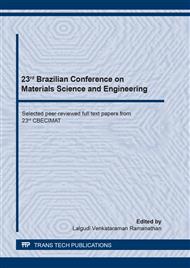p.109
p.114
p.119
p.125
p.131
p.136
p.141
p.147
p.153
Effects of Electrolyte Substitution on the Specific Capacitance and Equivalent Series Resistance of Energy Storage Electrochemical Supercapacitors
Abstract:
The microstructure, chemical composition, equivalent series resistance (ESR) and specific capacitance (Cs) of supercapacitors electrodes have been investigated. Commercial activated carbon electrodes employing organic electrolyte have been tested at a potential window of 1.1 and 2.7 V. Specific capacitances were calculated from cyclic voltammetry curves at room temperature employing various scan rates (2-70 mVs-1). Internal resistances of the supercapacitors were calculated using the galvanostatic cycling curves at several current densities (10-175 mAg-1). A maximum specific capacity of 58 Fg-1 has been achieved with the organic electrolyte at a current density of 30 mAg-1 and a potential window of 2.7V. After this initial study, the organic electrolyte was removed from the electrodes by back pumping vacuum. Two new aqueous electrolytes have been substituted in the commercial electrodes for a comparison: Na2SO4 and KOH (1.0 mol.L-1). At a discharge density of 75 mAg-1, the electrodes with KOH showed a maximum specific capacitance of 53 Fg-1 whereas the Na2SO4 showed only 6 Fg-1. ESR of the electrodes with organic electrolyte and KOH were in the range of 20 Ωcm2 whereas with Na2SO4 of 14 Ωcm2. The microstructures of the electrode material have been investigated using scanning electron microscopy (SEM) and chemical microanalyses employing energy dispersive X-ray analysis (EDX). A compositional and morphological evaluation of these electrodes showed a very homogeneous structure.
Info:
Periodical:
Pages:
131-135
Citation:
Online since:
October 2020
Authors:
Price:
Сopyright:
© 2020 Trans Tech Publications Ltd. All Rights Reserved
Share:
Citation:


